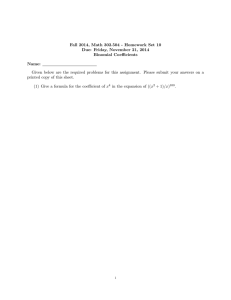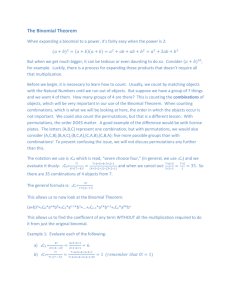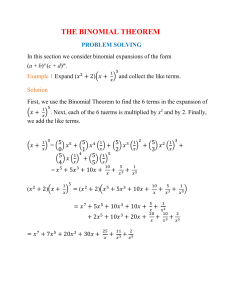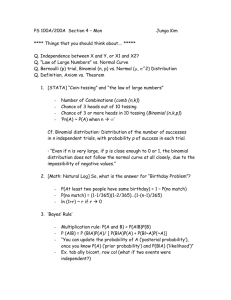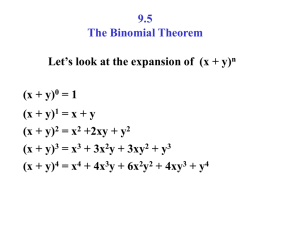Exercise 34: Binomial Theorem
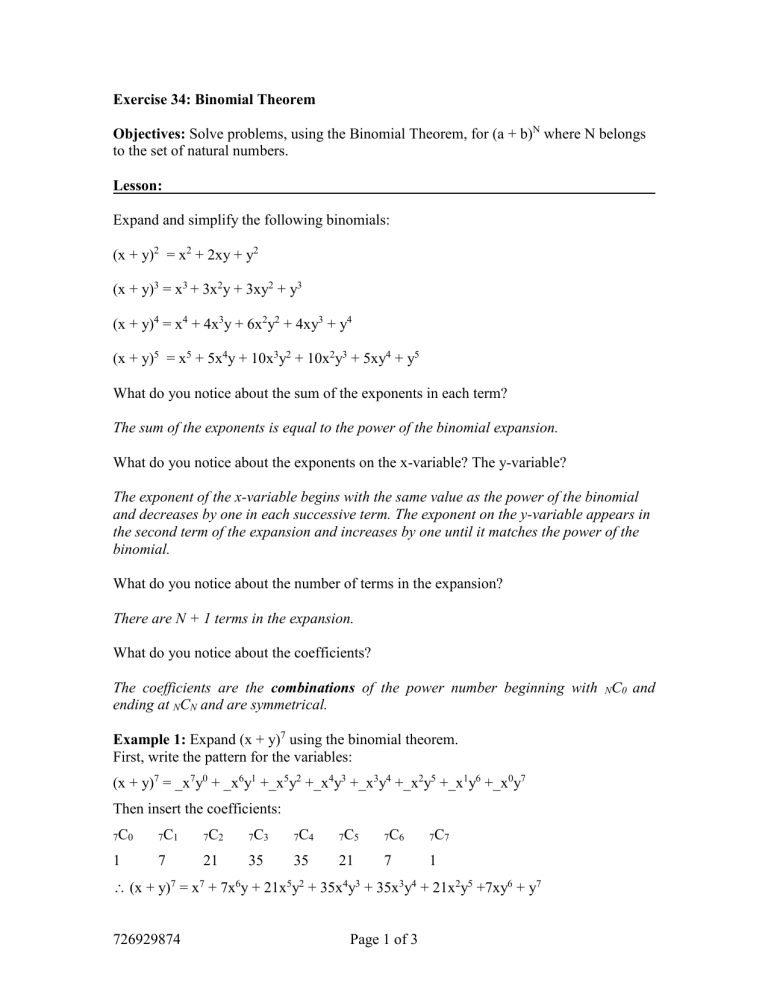
Exercise 34: Binomial Theorem
Objectives: Solve problems, using the Binomial Theorem, for (a + b) N where N belongs to the set of natural numbers.
Lesson:
Expand and simplify the following binomials:
(x + y)
2
= x
2
+ 2xy + y
2
(x + y)
3
= x
3
+ 3x
2 y + 3xy
2
+ y
3
(x + y)
4
= x
4
+ 4x
3 y + 6x
2 y
2
+ 4xy
3
+ y
4
(x + y) 5 = x 5 + 5x 4 y + 10x 3 y 2 + 10x 2 y 3 + 5xy 4 + y 5
What do you notice about the sum of the exponents in each term?
The sum of the exponents is equal to the power of the binomial expansion.
What do you notice about the exponents on the x-variable? The y-variable?
The exponent of the x-variable begins with the same value as the power of the binomial and decreases by one in each successive term. The exponent on the y-variable appears in the second term of the expansion and increases by one until it matches the power of the binomial.
What do you notice about the number of terms in the expansion?
There are N + 1 terms in the expansion.
What do you notice about the coefficients?
The coefficients are the combinations of the power number beginning with
N
C
0 and ending at
N
C
N
and are symmetrical.
Example 1: Expand (x + y)
7
using the binomial theorem.
First, write the pattern for the variables:
(x + y)
7
= _x
7 y
0
+ _x
6 y
1
+_x
5 y
2
+_x
4 y
3
+_x
3 y
4
+_x
2 y
5
+_x
1 y
6
+_x
0 y
7
Then insert the coefficients:
7
C
0 7
C
1 7
C
2 7
C
3 7
C
4 7
C
5 7
C
6 7
C
7
1 7 21 35 35 21 7 1
(x + y)
7
= x
7
+ 7x
6 y + 21x
5 y
2
+ 35x
4 y
3
+ 35x
3 y
4
+ 21x
2 y
5
+7xy
6
+ y
7
726929874 Page 1 of 3
The Binomial Theorem
The binomial theorem states that where n is any positive integer,
(x + y) n
=
n
0
x n
n
1
x n
1 y
n
2
x n
2 y
2
n
3
x n
3 y
3
...
n n
xy
1 n
1
n n
y n
Some additional important observations are: a) The exponent of the second term of the binomial, in the expansion, is the same as the number of objects being selected in the combination.
That is, we have for the (k+1) st
term:
n k
x n
k y k
These are always the same. b) Or, if we are looking for the k th
term, we look to the term:
k n
1 x n
k
1 y k
1 c) The sum of the exponents of any term of the expansion if (x + y) n
is n.
For example:
n
n
k k x y k
notice that n-k+k = n
Example 2: Use the binomial theorem to expand each of the following binomials:
(a – b)
6
=
6
C
0 a
6
(-b)
0
+
6
C
1 a
5
(-b)
1
+
6
C
2 a
4
(-b)
2
+
6
C
3 a
3
(-b)
3
+
6
C
4 a
2
(-b)
4
+
6
C
5 a
1
(-b)
5
+C
6 a
0
(-b)
6
= a
6
6a
5 b + 15a
4
(-b)
2
20a
3 b
3
+ 15a
2 b
4
6ab
5
+ b
6
(2x – y)
4
=
4
C
0
(2x)
4
(-y)
0
+
4
C
1
(2x)
3
(-y)
1
+
4
C
2
(2x)
2
(-y)
2
+
4
C
3
(2x)
1
(-y)
3
+
4
C
4
(2x)
0
(-y)
4
= 1
16x
4
1 + 4
8x
3
(-y) + 6
4x
2 y
2
+ 4
2x
(-y)
3
+ 1
y
4
= 16x
4
32x
3 y + 24x
2 y
2
8xy
3
+ y
4
Example 3: Find the simplified form of the eleventh term in the expansion of (x – 2) 13 .
13
C
10 x
13 – 10
(-2)
10
=
13
C
10 x
3
2
10
= 286
x 3
1024
= 292864x
3
726929874 Page 2 of 3
Example 4: Find the term in the expansion of
x
2
2 x
5
that involves x
4
.
We could solve this by expansion but that is very time consuming. Instead, consider what we already know: n = 5 a = x
2
b =
Ошибка!
We have:
5
C r
(x 2 ) 5 – r (
Ошибка!
) r
We can ignore the coefficient for now and simplify: x
10 – 2r
x
–r
= x
10 – 3r
We would like the exponent on x to be 4:
10 – 3r = 4
6 = 3r r = 2
Therefore:
5
C
2
(x
2
)
5 – 2
(
Ошибка!
)
2
= 10
x
6 Ошибка!
= 40 x
4
Example 5:
Use Pascal’s Triangle to expand (c + d) 5
(c + d)
5
= 1
c
5
+ 5
c
4 d + 10
c
3 d
2
+ 10
c
2 d
3
+ 5
cd
4
+ 1
d
5
Homework: Exercise 34
726929874 Page 3 of 3

